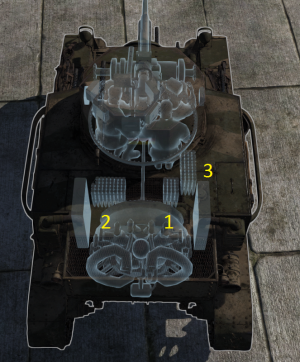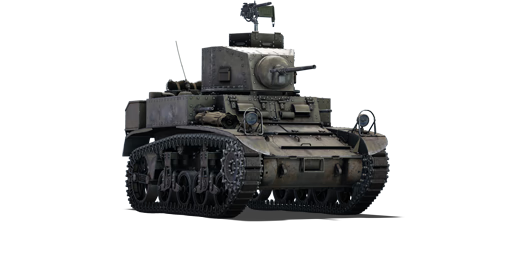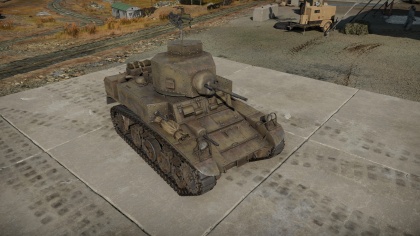M3 Stuart
Contents
| This page is about the American light tank M3 Stuart. For other uses, see M3 (Disambiguation). |
Description
The Light Tank M3 Stuart is a rank I American light tank
with a battle rating of 1.7 (AB) and 2.0 (RB/SB). It was one of the first American tanks to be released with the American ground tree in Update 1.45 "Steel Generals". With a better engine and transmission system than the M2 light tanks, the M3 Stuart is more able to manoeuvre the battlefield as a dependable light tank.
General info
Survivability and armour
Armour type:
- Rolled homogeneous armour
| Armour | Front | Sides | Rear | Roof |
|---|---|---|---|---|
| Hull | 38.1 mm (18°) Driver Port 15.8 mm (69°) Front Glacis |
25.4 mm | 25.4 mm | 12.7 mm |
| Turret | 38.1 mm | 25.4 mm | 25.4 mm | 12.7 mm |
Notes:
- Suspension wheels and bogies are 15 mm thick, tracks are 10 mm thick.
Mobility
| Game Mode | Max Speed (km/h) | Weight (tons) | Engine power (horsepower) | Power-to-weight ratio (hp/ton) | |||
|---|---|---|---|---|---|---|---|
| Forward | Reverse | Stock | Upgraded | Stock | Upgraded | ||
| Arcade | 56 | 7 | 12.7 | 406 | 500 | 31.97 | 39.37 |
| Realistic | 51 | 6 | 232 | 262 | 18.27 | 20.63 | |
Armaments
Main armament
| 37 mm M5 | |||||
|---|---|---|---|---|---|
| Capacity | Vertical guidance |
Horizontal guidance |
Stabilizer | ||
| 103 | -10°/+20° | ±180° | Vertical | ||
| Turret rotation speed (°/s) | |||||
| Mode | Stock | Upgraded | Prior + Full crew | Prior + Expert qualif. | Prior + Ace qualif. |
| Arcade | 19.04 | 26.35 | 32.00 | __.__ | 37.65 |
| Realistic | 11.90 | 14.00 | 17.00 | 18.80 | 20.00 |
| Reloading rate (seconds) | |||||
| Stock | Prior + Full crew | Prior + Expert qualif. | Prior + Ace qualif. | ||
| 3.77 | 3.33 | 3.07 | 2.90 | ||
Ammunition
| Penetration statistics | |||||||
|---|---|---|---|---|---|---|---|
| Ammunition | Type of warhead |
Penetration in mm @ 0° Angle of Attack | |||||
| 10m | 100m | 500m | 1000m | 1500m | 2000m | ||
| M74 shot | AP | 66 | 65 | 55 | 46 | 38 | 31 |
| M51 shot | APC | 66 | 65 | 55 | 46 | 38 | 31 |
| Shell details | |||||||||
|---|---|---|---|---|---|---|---|---|---|
| Ammunition | Velocity in m/s |
Projectile Mass in kg |
Fuse delay
in m: |
Fuse sensitivity
in mm: |
Explosive Mass in g (TNT equivalent): |
Normalization At 30° from horizontal: |
Ricochet: | ||
| 0% | 50% | 100% | |||||||
| M74 shot | 792 | 0.87 | N/A | N/A | N/A | -1° | 47° | 60° | 65° |
| M51 shot | 792 | 0.87 | N/A | N/A | N/A | +4° | 48° | 63° | 71° |
Ammo racks

| Full ammo |
1st rack empty |
2nd rack empty |
3rd rack empty |
Visual discrepancy |
|---|---|---|---|---|
| 103 | 69 (+34) | 35 (+68) | 1 (+102) | No |
Machine guns
| 7.62 mm M1919A4 | |||||||||||||
|---|---|---|---|---|---|---|---|---|---|---|---|---|---|
| Coaxial mount | |||||||||||||
| Capacity (Belt capacity) | Fire rate (shots/minute) |
Vertical guidance |
Horizontal guidance | ||||||||||
| 3,200 (250) | 500 | N/A | N/A | ||||||||||
| Pintle mount | |||||||||||||
| Capacity (Belt capacity) | Fire rate (shots/minute) |
Vertical guidance |
Horizontal guidance | ||||||||||
| 3,000 (250) | 500 | -10°/+70° | ±60° | ||||||||||
| Hull mount (#1) | Hull mount (#2) | ||||||||||||
| Capacity (Belt capacity) | Fire rate (shots/minute) |
Vertical guidance |
Horizontal guidance |
Capacity (Belt capacity) | Fire rate (shots/minute) |
Vertical guidance |
Horizontal guidance | ||||||
| 3,200 (250) | 500 | N/A | N/A | 3,200 (250) | 500 | N/A | N/A | ||||||
Usage in battles
The M3 Stuart works best from a distance where its armour can shine and its gun can provide fast covering fire. However, this tank also works well in tight spaces if the armour is angled correctly, thanks to its ability to bounce shots and destroy the enemy with its AP ammunition.
Pros and cons
Pros:
- Good front armour.
- Fast and agile.
- Reliable gun with good rate of fire.
Cons:
- Tank is cramped, one shot can knock out most crew members.
- Braking System unresponsive.
- Backwards Traverse is slow.
- Turning can be hit or miss.
- No ammunition with HE filler.
History
Development
The American light tank design prior to World War II, the M2 light tank, was seen as obsolete after observing Germany's Panzer forces tear through Europe. The design was to be upgraded with more armour, a better suspension, and a new gun recoil system. The revised version was designated the Light Tank M3, which the British named the Stuart. At its basis, the light tank had a 37 mm cannon with a similar layout as the M2 light tank, with the radial engine at the rear and the transmission on the front, though the radial engine was in high demand so the Guiberson diesel T-1210 were fitted in some models to substitute the engine. The design used the VVSS bogie system seen on previous American tank designs. The tank had a crew of four: driver, assistant driver, gunner, and commander, who doubled as the loader.
The first variant of the M3 Stuart light tank was very similar to the M2 light tanks. It had five machine gun armaments scattered around like the M2, but featured better armour and a better cannon with the 37 mm M6 cannon. The design did not have a turret basket for the crew and it was constructed out of rivets, which increased the chance of spalling in the tank. Nevertheless, the first variant M3 saw about 5,811 units produced. The second variant, the M3A1 Stuart, featured a new turret with no cupola on it, plus an added gun stabilizer. The machine guns on the hull sides were removed, so now the total machine guns were reduced from five to three. The design also featured a welded armour design to remove the weakness of riveted armour. 4,621 of this variant was produced from May 1942 to February 1943. The most used variant, the M5A1 Stuart, had a completely redesigned hull and turret, with the hull most notably having a full sloping frontal armour than the previous designs. This variant had about 6,810 units produced. All in all, the M3 light tank design and all its later variants were produced in massive quantities from March 1941 to October 1943 with a total of 25,000 units produced.
Combat usage
The British were the first to use the M3 Stuart in Africa in 1941, using it in Operation Crusader. However, the result ended with heavy losses, due to the better training the German Afrika Korps had compared to the British tank doctrine. The encounter also pointed out many flaws in the M3, mainly the cramped interior and limited operational range, but was praised for its high mobility and reliability when compared to the British contemporary designs. In 1942, the Stuarts were generally kept as recon units rather than combat units, and some were even modified to improve speed and range by removing the turret, and others were converted to armoured personnel carriers and command vehicles. Though the British used it extensively, it was still in small proportion compared to American usage. The Soviet Union was also another user of the M3 but found it unfavourable due to their own logistics, plus it was not made to withstand the Russian Rasputitsa or even the winter. The Soviet eventually turned down any more offers for the Stuart by 1943. The M3s also supported the British and Chinese forces in Asia against the Japanese Army, and also France and Yugoslavia in Europe against the German Wehrmacht.
The Americans used it widely in both operational theatres. In the Pacific, the M3s were the first tanks America used in a tank vs. tank operation against the Imperial Japanese Army, where five M3s fought Type 95 Ha-Gos in a well-known action in the Phillippines. In total 108 M3s served with the 192nd and 194th Tank Battalions, also known as the 1st Provisional Tank Group, in the 1941 U.S. defence of the Phillippines, despite having no HE ammo issued. More than 30 were captured by the Japanese, who equipped their 7th Tank Regiment with them, who used them to defend the Philippines again, against the US in 1944. M3s were also used by Company B of the 1st Marine Tank Battalion at Guadalcanal in 1942. Though the Stuarts were newer than the Japanese tank designs by about five years, they were seen as equal in performance and firepower, but the M3 benefited by the support of the American industry arm. The Stuarts served in the Pacific slightly better than its heavier counterparts such as the M4 Shermans due to its lighter weight and manoeuvrability in the poor jungle terrain, but the M3 Stuarts in the Pacific were gradually replaced by M4 Shermans due to heavy losses from its thinner armour. The M3 was also some of the first US tanks to be converted into flamethrower tanks, named as the "Satan". The Satan tanks provided favourable results to the concept of a flamethrower tank and were replaced by flamethrower-equipped M4 Shermans in 1945.
In Europe, the M3 formed a large part of the American tank battalions, though following the British path by sidelining the Stuarts from combat duties after heavy losses and to serve alongside Shermans as scouting units. A typical tank battalion for the US Army consisted of three companies of Shermans and one of Stuarts. Other than scouting, the M3s were also used in cavalry roles and infantry support since their cannon are unable to compete with the German tank designs. Despite their dwindling capabilities in battle, the M3 was kept in service up until the end of the war due to the large production numbers.
After World War II, the Stuarts were given out as cheap surplus, countries such as China, India, and Pakistan picked up a few and used them in their conflicts. Portuguese also picked up a few M3s for the war in Angola, and the South African Corps continued using the Stuarts until 1955, where some were still kept in service until 1968 due to available parts. Today, Paraguay is still a user of the M3 light tanks, though as the only tracked armour used in the country.
The Stuart light tank design was also quite versatile that it was made into different variants for different roles on the battlefield. It served as an infantry support vehicle as to the 75mm GMC M8 and experiments were also taken to see if it could be adapted to an anti-aircraft gun and a flamethrower as well. However, the M3 was becoming an ageing design with inferior armour, cramped interior layout, and a small 37 mm gun, so a program to replace the light tank began in 1943 and became the M24 Chaffee, which would eventually replace the M3 Light Tank mostly after World War II.
In-game description
"At the beginning of 1940 the Ordnance Department put together technical requirements for a new tank, the need for which was clear at the beginning of World War II. The first prototype was refashioned after the M2A4 at the Rock Island Arsenal. The tank had a riveted turret with few viewing slits, and the new M22 mantlet had thicker armor. The hull's frontal armor was also thickened to 45 mm and the turret to 38 mm. The tank hull was assembled from rolled armor plates on a frame made from angle sections and flat bars using rivets, though later releases were partially welded.
From the end of 1941 to the beginning of 1942 a lack of standard gas-powered Continental aircraft engines forced some tanks to be outfitted with 265 hp Guiberson T-1020-4 diesel-powered, nine-cylinder, air-cooled radial engines capable of reaching 2,250 rpm. The diesel tanks could be recognized by their Vortex air filters and were generally designated M3 diesels. At the end of 1941 the tanks with carburetor engines were equipped with two cylindrically-shaped external fuel tanks, each with a capacity of 102 liters, that were connected to the engine supply system. After being exhausted, the external tanks could be jettisoned by the crew without leaving the tank. Adding the new tanks doubled the M3's range.
On July 5, 1940, the new light tank was standardized and released under the M3 designation. It was more widely known by the moniker General Stuart, given it by the British, who received a significant number of them in 1941 and 1942 via Lend-Lease.
Production of the M3 began in March 1941 at the American Car & Foundry factory. March 1941 through August 1942 saw 5,811 built, 1,285 of which were equipped with the Guiberson T-1020-4 engine.
M3 Stuart light tanks were also delivered to the Red Army and the UK via Lend-Lease to be used on all fronts in World War II beginning in 1941."
Media
Skins and camouflages for the M3 Stuart from live.warthunder.com.
See also
External links
Paste links to sources and external resources, such as:
- topic on the official game forum;
- encyclopedia page on tank;
- other literature.
| USA light tanks | |
|---|---|
| LVT | LVT(A)(1) · ○LVT(A)(1) · LVT(A)(4) |
| M2 | M2A2 · M2A4 · M2A4 (1st Arm.Div.) |
| M3/M5 Stuart | M3 Stuart · M3A1 Stuart · M3A1 (USMC) · M5A1 · M5A1 TD · ▃Stuart VI (5th CAD) |
| M22 Locust | M22 |
| M24 Chaffee | M24 · M24 (TL) |
| M18 Hellcat | M18 GMC · M18 "Black Cat" · Super Hellcat |
| M41 Walker Bulldog | M41A1 |
| M551 Sheridan | M551 · M551(76) |
| M3 Bradley | M3 Bradley · M3A3 Bradley |
| Wheeled | M8 LAC · T18E2 · M1128 · M1128 Wolfpack |
| Other | M8A1 GMC · T92 · T114 · HSTV-L · CCVL · XM8 · XM800T · AGS |





